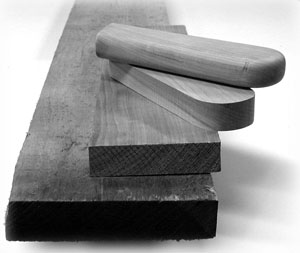Wood for Horses
American woods vary considerably in texture, hardness, color and figure. Sugar Maple, a very pale wood, contrasts sharply with a dark wood like Black Walnut. Some woods are a joy to shape with sharp tools, others notoriously contrary. I usually choose a wood like Black Walnut, Black Cherry or Red Oak. These hardwoods show less wear and tear than softer woods like Pine, though pine is certainly strong enough. Many antiques are made of Pine and have proven quite durable; yet if you envision their antique surfaces, the word distressed comes to mind.
Black Cherry is my favorite. Cherry lumber is medium red in color and darkens over the years. When your riders reach their teens it will be a deep red. I especially like its property of wearing smoother and smoother with use, a quality that weavers find useful for loom shuttles, and I find pleasant in toys.
Red Oak is the hardest of the three and an excellent choice, with its prominent grain that becomes golden with time. Red Oak's coarser texture has a different character than Cherry or Walnut, yet it feels pleasant to your touch. One of the most abundant trees east of the Great Plains, Red Oak has a long tradition of usefulness, beginning before colonial times. Its abundance translates into a lower price at the lumber company.
Deep brown in color, Black Walnut has been revered by woodworkers for centuries, prized for both its working qualities and its color. Today this reverence is expressed in price; walnut is the most expensive of the three.
All these woods are hard, heavy, and strong enough to support a 300 pound horseman. This overcapacity will ensure a graceful old age with no sway-back. Importantly, they are all favored for their working qualities, and sharp tools leave crisp, smooth surfaces that need little sanding. Other good choices include: White Ash, Beech, Sugar Maple and Hickory, although they are difficult to find in thicknesses appropriate for this rocking horse.
Another family made horse and lucky buckaroo.


As a youth on an island in Maine, I started designing spontaneously. I didn't draw something on paper and ask a carpenter to build it for me. I executed my own designing. I often had to make my own tools and procure my materials directly from the landscape. I would go into the woods and cut my own trees, dress them out, cure them, and then fashion them into their use form.
R. Buckminster Fuller

The master would choose and buy standing trees, and they would be felled and trimmed and brought to his yard to await the arrival of the sawyers...When the timber had been sawn into the required planks and pieces it was carefully stacked so that air, atmosphere and time did their full work upon the wood to season it, and this would take a matter of years.
Jocelyn Bailey
The Village Wheelwright - 1975
